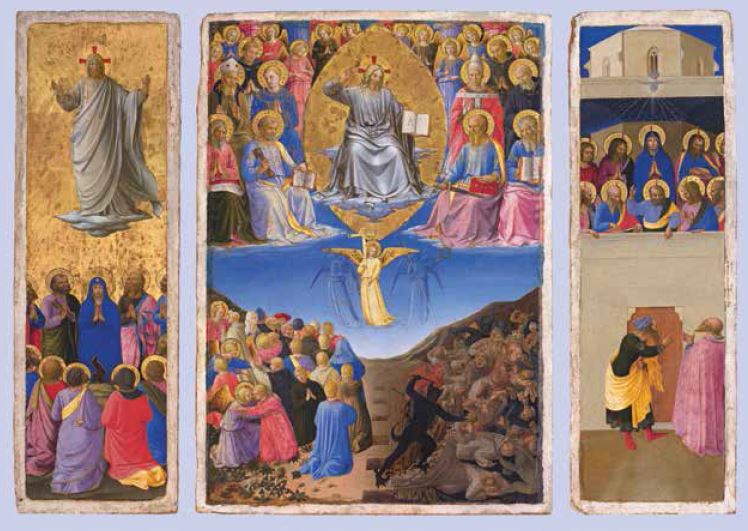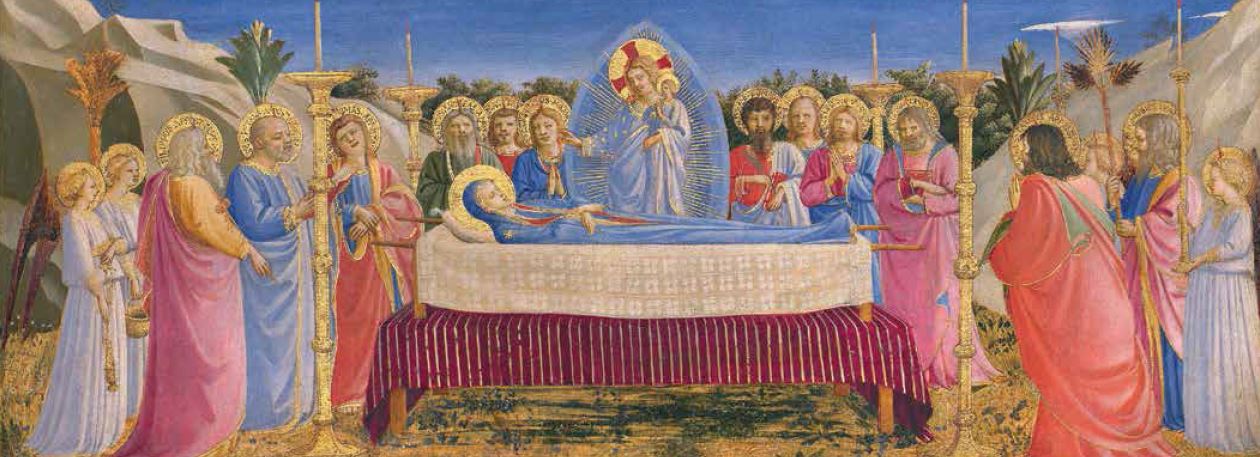Heavenly Brushstrokes: Fra Angelico Exhibit Offers Colorful Masterpieces
In Boston, color contemplates the celestial.

If St. Thomas Aquinas is called the “Angelic Doctor,” fellow Dominican Fra Angelico could be dubbed the “Angelic Painter,” along with his time-honored moniker that translates to “Angelic Friar.”
Fra Giovanni Angelico da Fiesole (1390-95-1455), born Guido di Pietro, was beatified by Pope St. John Paul II in 1982, becoming a patron of painters.
Fra Angelico painted for two popes and the Medici family, and through his sacred paintings and frescoes, he proclaimed the Gospel of Jesus Christ, one brushstroke at a time.
The exhibit “Fra Angelico: Heaven on Earth” showcases his sacred art at the Isabella Gardner Museum in Boston, Massachusetts.
For the first time in more than two centuries, four newly restored panels from reliquaries that the 15th-century Dominican friar painted between 1424 and 1434 are on display together.
One of the reliquaries — Dormition and Assumption of the Virgin — was the first Fra Angelico work to come to America. Bostonian Isabella Gardner obtained it in 1899. The others have arrived from the Museo di San Marco in Florence. Joining these reliquary panels are other major works from the Uffizi in Italy, the National Gallery of Art in Washington and elsewhere.
The visual feast pays tribute to Fra Angelico, who is considered one of the pre-eminent Renaissance painters. The spirituality of heaven shines through his paintings. From his earliest efforts, he brought forth illuminating images. Subtle touches, minute details and obvious emotions in faces characterize his depictions of Gospel events. Indeed, Fra Angelico seemed to have had an exceptionally keen intuition for translating the word of God into creative works inspired by God. Giorgio Vasari attests to this in his 16th-century Lives of the Artists: “It was his habit never to retouch or alter any of his paintings, but to leave them as they came the first time, believing, as he said, that such was the will of God.”
He added: “Fra Giovanni would never have taken his brushes in his hand without first offering a prayer.”
Reliquaries Reunited
Fra Angelico painted the four reunited reliquaries for the Church of Santa Maria Novella, the Dominicans’ Florentine headquarters between about 1426 and 1434. These magnificent works, of tempura, gold and oil glaze on panels, originally held relics of saints.
The last to be painted was the Gardner Museum’s Dormition and Assumption of the Virgin.
In this artwork, depicting the dormition (falling asleep) of the Virgin Mary, a small child represents Mary’s soul, as each face expresses a personal meditation or sentiment. Fra Angelico was said to be a master at presenting individual personalities, turning facial expressions into insightful snapshots of thoughts and emotions, revealing each one’s mind and heart.
Fra Angelico is said to have had a powerful way of infusing his scenes with carefully measured spirituality, too. Here, Mary and Jesus appear with a majestic humility — and humble majesty.
Both scenes on this reliquary are full of brilliant blues, pinks and golds, trademark color that distinguishes Fra Angelico’s works.
Dressed in light blue copiously decorated with gold accents, Mary is portrayed being drawn up to heaven by a host of angels venerating her, some playing trumpets and stringed instruments. Her arms and eyes look heavenward toward Jesus, who is surrounded in a deeper blue aureole. With outstretched arms, he readies to welcome his mother.
Golden radiance streaming out liked combed, silken sun rays surrounds the Virgin Mary. The rays seem to move, glistening when viewed from different angles. Joining vibrant shades of blue are the purest of pinks, plus vermillion and green. Fra Angelico developed a way to extract brilliant blue, or ultramarine, hues from semi-precious lapis lazuli. The color came to be called “Fra Angelico blue.”
The next reliquary, Madonna della Stella (Madonna of the Star), presents Mary in a pink tunic and brilliant blue veil decorated with a golden star. She holds the Child Jesus, snuggling next to her cheek. Gold radiance gleams around her, as angels form an arch about her. Awaiting her is a gold crown and Jesus in vermillion tunic, surrounded by an intense blue aureole filled with cherubs.
The other two reliquaries are no less dramatic and riveting for their beauty. The first presents the two-part Annunciation and The Adoration of the Magi in finest details of facial features, clothing and decoration. The events are dramatic, as Gabriel visits the Virgin Mary and then come the Magi, appearing as medieval kings, as Mary, with Joseph beside her, offers the Christ Child for their homage.
The Coronation of the Virgin depicts a remarkable celestial scene, with Christ crowning Mary. With Jesus and Mary adorned in blue, vermillion and gold, the scene has angels watching and playing musical instruments, as saints witness the coronation taking place at the top of a multihued staircase. The saint facing the viewer is Thomas Aquinas, showing a Bible opened to the Psalms.
Sacred Artistry
The visual treasures amass one after another. The Ascension of Christ, The Last Judgment and Pentecost — known as the Corsini Triptych, on loan from the Gallerie Nazionali d’Arte Antica in Rome — presents three biblical scenes in vivid color. In one panel, Christ ascends into heaven through a golden sky as the apostles worship. Prayerfully, Mary is shown focusing her eyes upward to Christ. The opposite panel pictures the Holy Spirit descending on Pentecost.
In the central panel, Fra Angelico uses an eye-catching palette of blues, pinks and golds, as Christ, in silvery robes, passes judgment on the living and dead via Matthew 25. Here, as elsewhere, the museum’s notes are excellent, defining how Fra Angelico’s format accentuates the heaven-earth relationship, “emphasizing the Church’s power of salvation through Christ.”
These works attest to Fra Angelico’s attention to the tiniest details. At times it’s as if he painted with a single bristle. Then in other places there’s tooled gold, or gold “combed out” into perfect geometric rays. At times the golden wings of angels appear to be three-dimensional feathers.
Add to this the carefully embroidered gold on Gabriel’s tunic, the intricately patterned carpet for the Annunciation, or the geometric design on the bier (coffin) in another version of Dormition of the Virgin. The individual blades of grass seem so lifelike, sprinkled with flowers, in Adoration of the Magi. And the Holy Spirit sitting atop St. Joseph’s staff that has a lily in bloom and the perfectly draped clothing in The Marriage of the Virgin all convey the artist’s care.
This last joyous scene, with many onlookers, is quite serene, in softer blues and pinks. Fra Angelico dresses everyone in Renaissance style. Like many scenes, he sets this event amid Tuscan details, connecting the architecture with the local environment.
The Entombment of Christ is set in the Tuscan countryside for the same reasons. The mourners and saints in this piece evoke peace and calm, calling for meditation.
Heavenly Lessons
In the extensive Paradise, scores of saints and an orchestra of angels celebrate Christ crowning the Virgin Mary. Ornately engraved gold radiates grandeur, while Mary and Jesus are seated on an ultramarine blue cloud. Our Lady wears blue, from ultramarine to softer shades, while Christ adds a gem to her crown. Fra Angelico embossed their clothing with gold-on-gold filigrees. In addition, Mary’s crown radiates with meticulously ornate details.
Throughout the exhibit, color contemplates the celestial.
Vasari wrote that “the whole coloring of that work appears to be by the hand of a saint or an angel like themselves; wherefore it was with very good reason that this excellent monk was ever called Fra Giovanni Angelico.”
Joseph Pronechen is a
Register staff writer.
INFORMATION
The exhibit runs through May 20. For more information, visit GardnerMuseum.org.
- Keywords:
- church art
- fra angelico
- joseph pronechen


















